MNG93100 S2 2018: Stakeholder Engagement in Engineering Report
VerifiedAdded on 2023/06/08
|13
|3808
|127
Report
AI Summary
This report provides an in-depth literature review of stakeholder engagement within the engineering and asset management sector, with a specific focus on the construction of parallel runways. It examines the Sydney Airport project, alongside other runway projects, such as the Brisbane Airport's current parallel runway, to understand the impact of stakeholder engagement. The report explores seminal works, current academic research, and case studies to evaluate the evolution of stakeholder engagement strategies. It discusses the importance of stakeholder involvement, the challenges faced, and the management of stakeholder engagement plans. The analysis considers the impact of noise pollution, community relations, and CSR initiatives. The study highlights the importance of communication, automation, and corporate social responsibility in successful project outcomes. The report aims to provide insights into effective strategies for engaging stakeholders in engineering projects, particularly in the context of infrastructure development and its impact on local communities and the environment. The report emphasizes the importance of learning from past projects to inform stakeholder engagement plans for future projects.
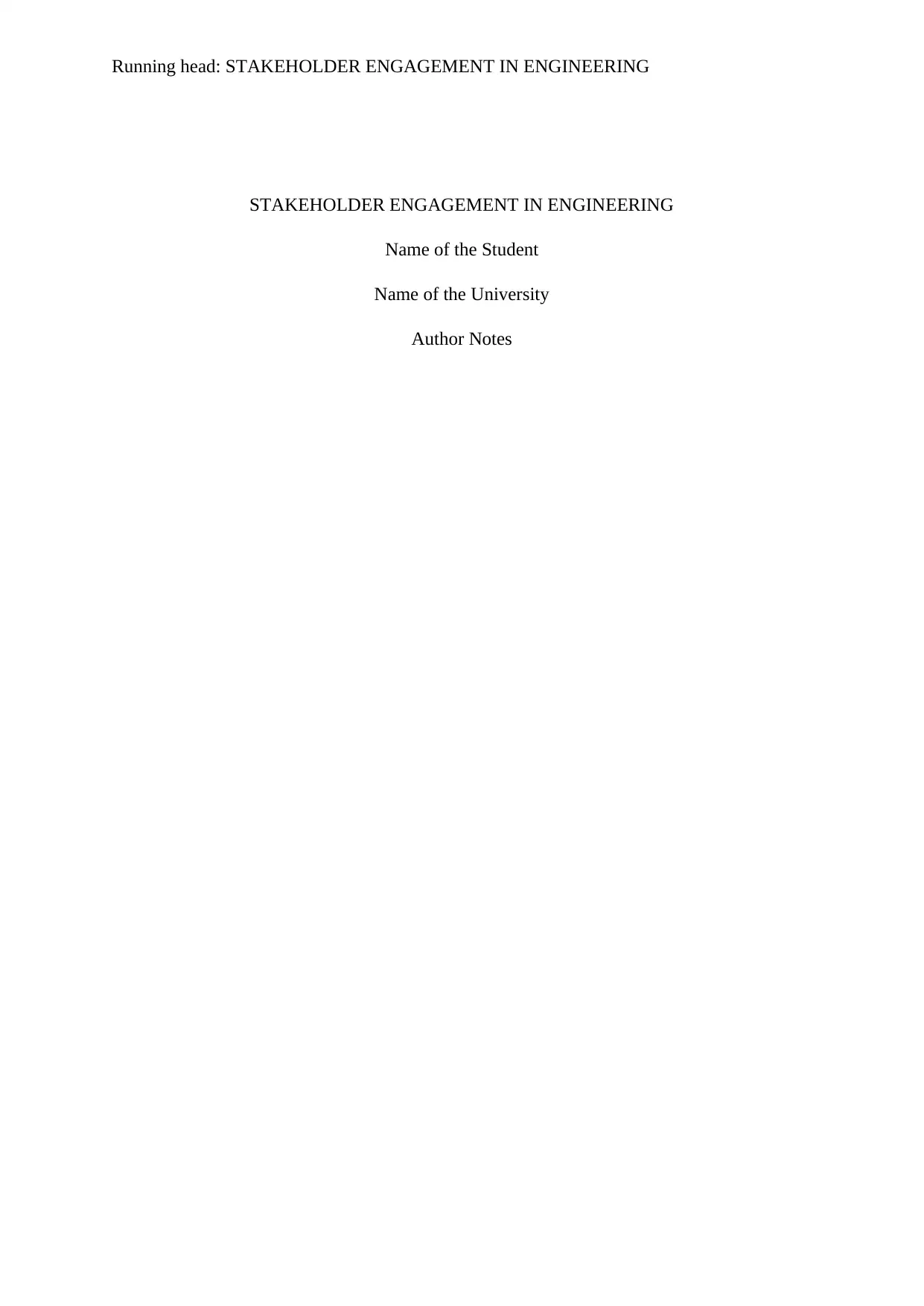
Running head: STAKEHOLDER ENGAGEMENT IN ENGINEERING
STAKEHOLDER ENGAGEMENT IN ENGINEERING
Name of the Student
Name of the University
Author Notes
STAKEHOLDER ENGAGEMENT IN ENGINEERING
Name of the Student
Name of the University
Author Notes
Paraphrase This Document
Need a fresh take? Get an instant paraphrase of this document with our AI Paraphraser
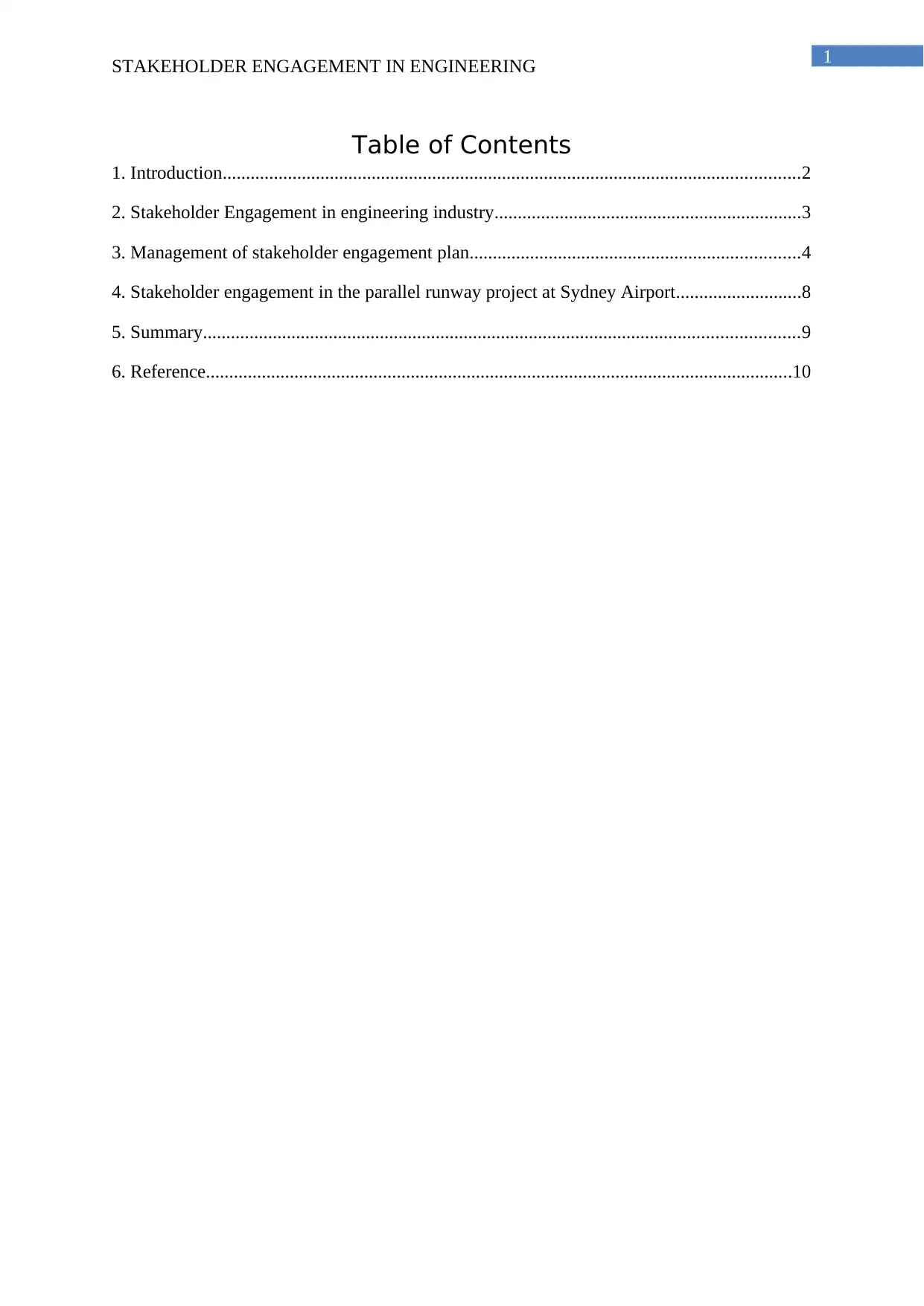
1
STAKEHOLDER ENGAGEMENT IN ENGINEERING
Table of Contents
1. Introduction............................................................................................................................2
2. Stakeholder Engagement in engineering industry..................................................................3
3. Management of stakeholder engagement plan.......................................................................4
4. Stakeholder engagement in the parallel runway project at Sydney Airport...........................8
5. Summary................................................................................................................................9
6. Reference..............................................................................................................................10
STAKEHOLDER ENGAGEMENT IN ENGINEERING
Table of Contents
1. Introduction............................................................................................................................2
2. Stakeholder Engagement in engineering industry..................................................................3
3. Management of stakeholder engagement plan.......................................................................4
4. Stakeholder engagement in the parallel runway project at Sydney Airport...........................8
5. Summary................................................................................................................................9
6. Reference..............................................................................................................................10
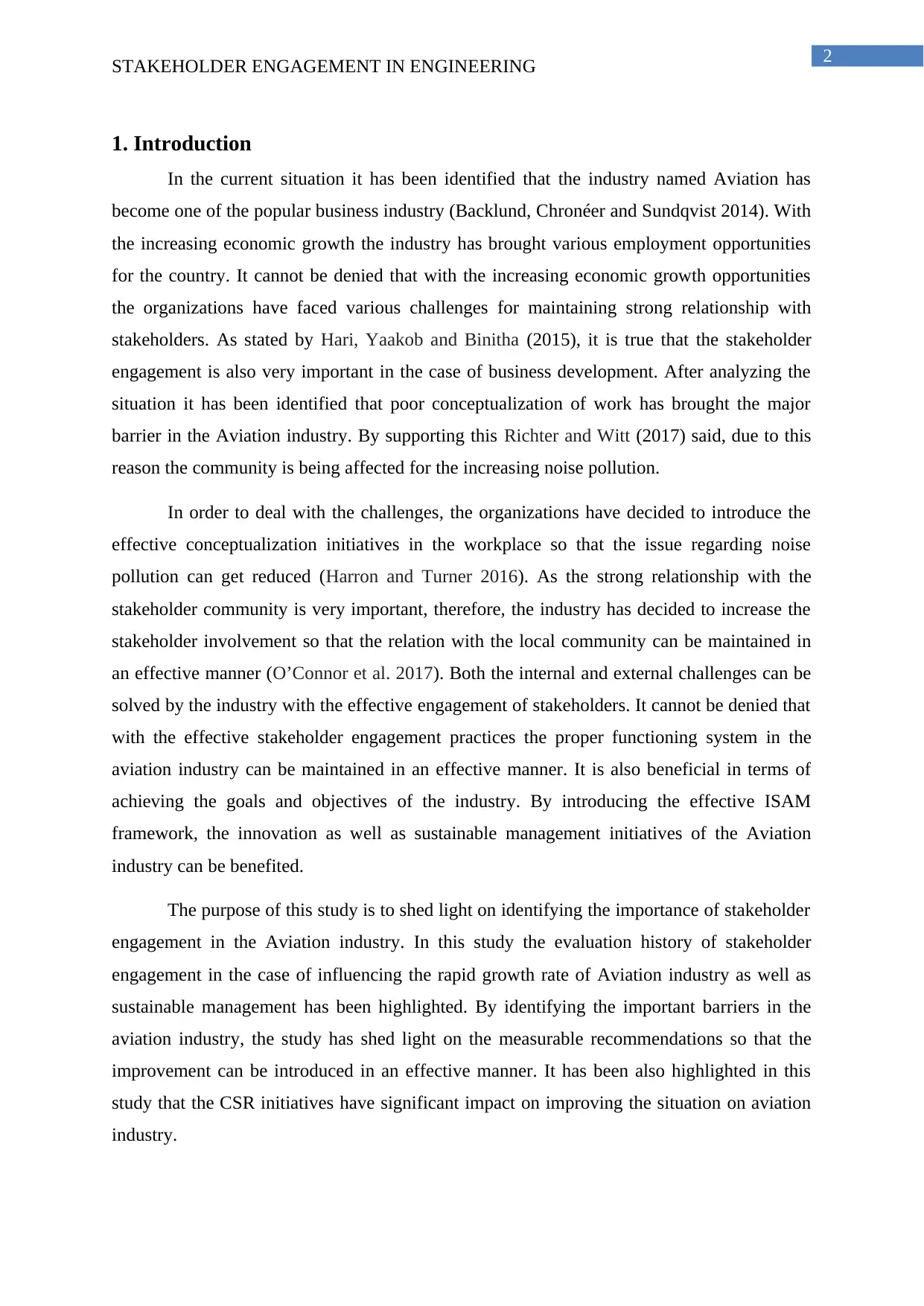
2
STAKEHOLDER ENGAGEMENT IN ENGINEERING
1. Introduction
In the current situation it has been identified that the industry named Aviation has
become one of the popular business industry (Backlund, Chronéer and Sundqvist 2014). With
the increasing economic growth the industry has brought various employment opportunities
for the country. It cannot be denied that with the increasing economic growth opportunities
the organizations have faced various challenges for maintaining strong relationship with
stakeholders. As stated by Hari, Yaakob and Binitha (2015), it is true that the stakeholder
engagement is also very important in the case of business development. After analyzing the
situation it has been identified that poor conceptualization of work has brought the major
barrier in the Aviation industry. By supporting this Richter and Witt (2017) said, due to this
reason the community is being affected for the increasing noise pollution.
In order to deal with the challenges, the organizations have decided to introduce the
effective conceptualization initiatives in the workplace so that the issue regarding noise
pollution can get reduced (Harron and Turner 2016). As the strong relationship with the
stakeholder community is very important, therefore, the industry has decided to increase the
stakeholder involvement so that the relation with the local community can be maintained in
an effective manner (O’Connor et al. 2017). Both the internal and external challenges can be
solved by the industry with the effective engagement of stakeholders. It cannot be denied that
with the effective stakeholder engagement practices the proper functioning system in the
aviation industry can be maintained in an effective manner. It is also beneficial in terms of
achieving the goals and objectives of the industry. By introducing the effective ISAM
framework, the innovation as well as sustainable management initiatives of the Aviation
industry can be benefited.
The purpose of this study is to shed light on identifying the importance of stakeholder
engagement in the Aviation industry. In this study the evaluation history of stakeholder
engagement in the case of influencing the rapid growth rate of Aviation industry as well as
sustainable management has been highlighted. By identifying the important barriers in the
aviation industry, the study has shed light on the measurable recommendations so that the
improvement can be introduced in an effective manner. It has been also highlighted in this
study that the CSR initiatives have significant impact on improving the situation on aviation
industry.
STAKEHOLDER ENGAGEMENT IN ENGINEERING
1. Introduction
In the current situation it has been identified that the industry named Aviation has
become one of the popular business industry (Backlund, Chronéer and Sundqvist 2014). With
the increasing economic growth the industry has brought various employment opportunities
for the country. It cannot be denied that with the increasing economic growth opportunities
the organizations have faced various challenges for maintaining strong relationship with
stakeholders. As stated by Hari, Yaakob and Binitha (2015), it is true that the stakeholder
engagement is also very important in the case of business development. After analyzing the
situation it has been identified that poor conceptualization of work has brought the major
barrier in the Aviation industry. By supporting this Richter and Witt (2017) said, due to this
reason the community is being affected for the increasing noise pollution.
In order to deal with the challenges, the organizations have decided to introduce the
effective conceptualization initiatives in the workplace so that the issue regarding noise
pollution can get reduced (Harron and Turner 2016). As the strong relationship with the
stakeholder community is very important, therefore, the industry has decided to increase the
stakeholder involvement so that the relation with the local community can be maintained in
an effective manner (O’Connor et al. 2017). Both the internal and external challenges can be
solved by the industry with the effective engagement of stakeholders. It cannot be denied that
with the effective stakeholder engagement practices the proper functioning system in the
aviation industry can be maintained in an effective manner. It is also beneficial in terms of
achieving the goals and objectives of the industry. By introducing the effective ISAM
framework, the innovation as well as sustainable management initiatives of the Aviation
industry can be benefited.
The purpose of this study is to shed light on identifying the importance of stakeholder
engagement in the Aviation industry. In this study the evaluation history of stakeholder
engagement in the case of influencing the rapid growth rate of Aviation industry as well as
sustainable management has been highlighted. By identifying the important barriers in the
aviation industry, the study has shed light on the measurable recommendations so that the
improvement can be introduced in an effective manner. It has been also highlighted in this
study that the CSR initiatives have significant impact on improving the situation on aviation
industry.
⊘ This is a preview!⊘
Do you want full access?
Subscribe today to unlock all pages.

Trusted by 1+ million students worldwide
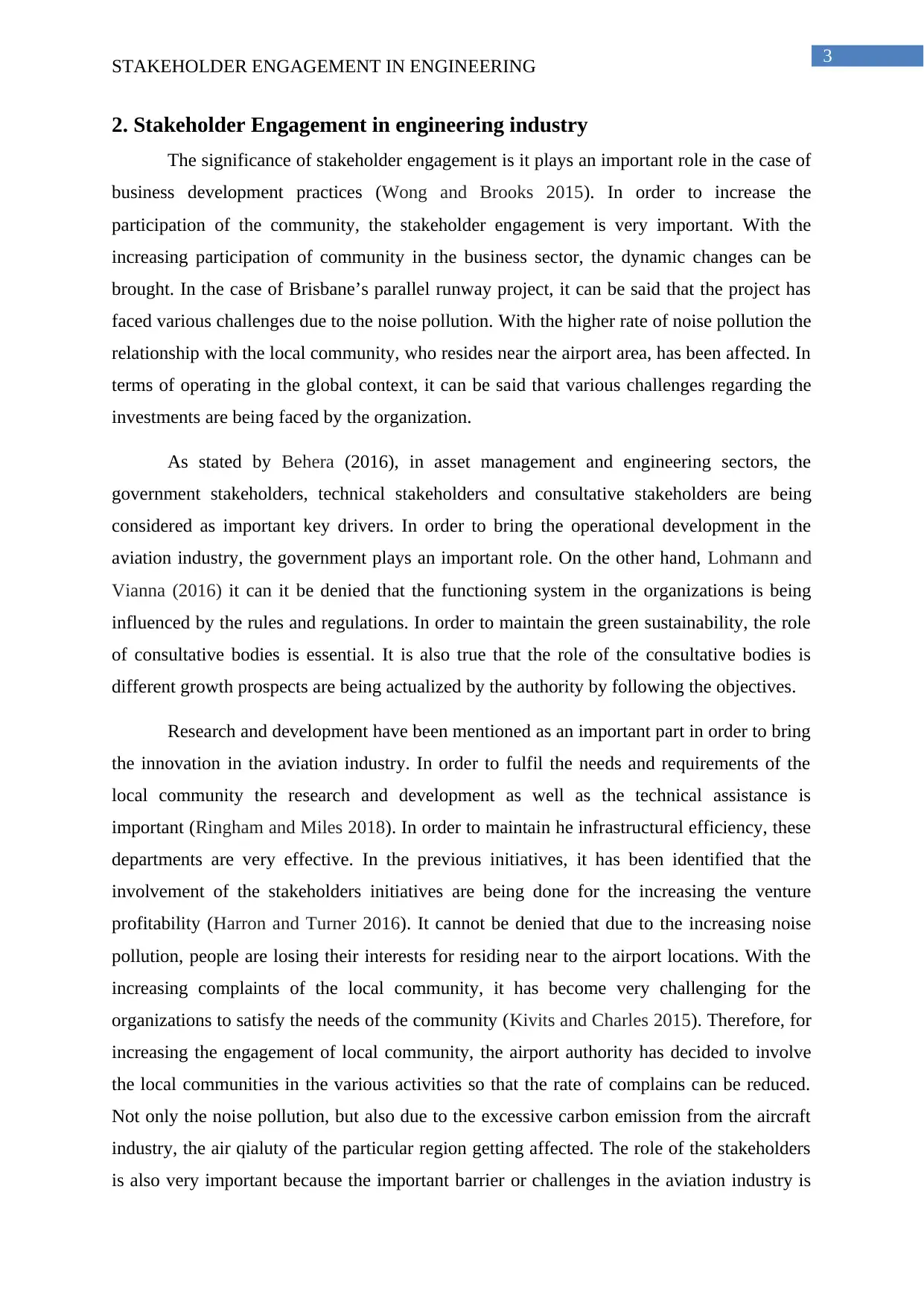
3
STAKEHOLDER ENGAGEMENT IN ENGINEERING
2. Stakeholder Engagement in engineering industry
The significance of stakeholder engagement is it plays an important role in the case of
business development practices (Wong and Brooks 2015). In order to increase the
participation of the community, the stakeholder engagement is very important. With the
increasing participation of community in the business sector, the dynamic changes can be
brought. In the case of Brisbane’s parallel runway project, it can be said that the project has
faced various challenges due to the noise pollution. With the higher rate of noise pollution the
relationship with the local community, who resides near the airport area, has been affected. In
terms of operating in the global context, it can be said that various challenges regarding the
investments are being faced by the organization.
As stated by Behera (2016), in asset management and engineering sectors, the
government stakeholders, technical stakeholders and consultative stakeholders are being
considered as important key drivers. In order to bring the operational development in the
aviation industry, the government plays an important role. On the other hand, Lohmann and
Vianna (2016) it can it be denied that the functioning system in the organizations is being
influenced by the rules and regulations. In order to maintain the green sustainability, the role
of consultative bodies is essential. It is also true that the role of the consultative bodies is
different growth prospects are being actualized by the authority by following the objectives.
Research and development have been mentioned as an important part in order to bring
the innovation in the aviation industry. In order to fulfil the needs and requirements of the
local community the research and development as well as the technical assistance is
important (Ringham and Miles 2018). In order to maintain he infrastructural efficiency, these
departments are very effective. In the previous initiatives, it has been identified that the
involvement of the stakeholders initiatives are being done for the increasing the venture
profitability (Harron and Turner 2016). It cannot be denied that due to the increasing noise
pollution, people are losing their interests for residing near to the airport locations. With the
increasing complaints of the local community, it has become very challenging for the
organizations to satisfy the needs of the community (Kivits and Charles 2015). Therefore, for
increasing the engagement of local community, the airport authority has decided to involve
the local communities in the various activities so that the rate of complains can be reduced.
Not only the noise pollution, but also due to the excessive carbon emission from the aircraft
industry, the air qialuty of the particular region getting affected. The role of the stakeholders
is also very important because the important barrier or challenges in the aviation industry is
STAKEHOLDER ENGAGEMENT IN ENGINEERING
2. Stakeholder Engagement in engineering industry
The significance of stakeholder engagement is it plays an important role in the case of
business development practices (Wong and Brooks 2015). In order to increase the
participation of the community, the stakeholder engagement is very important. With the
increasing participation of community in the business sector, the dynamic changes can be
brought. In the case of Brisbane’s parallel runway project, it can be said that the project has
faced various challenges due to the noise pollution. With the higher rate of noise pollution the
relationship with the local community, who resides near the airport area, has been affected. In
terms of operating in the global context, it can be said that various challenges regarding the
investments are being faced by the organization.
As stated by Behera (2016), in asset management and engineering sectors, the
government stakeholders, technical stakeholders and consultative stakeholders are being
considered as important key drivers. In order to bring the operational development in the
aviation industry, the government plays an important role. On the other hand, Lohmann and
Vianna (2016) it can it be denied that the functioning system in the organizations is being
influenced by the rules and regulations. In order to maintain the green sustainability, the role
of consultative bodies is essential. It is also true that the role of the consultative bodies is
different growth prospects are being actualized by the authority by following the objectives.
Research and development have been mentioned as an important part in order to bring
the innovation in the aviation industry. In order to fulfil the needs and requirements of the
local community the research and development as well as the technical assistance is
important (Ringham and Miles 2018). In order to maintain he infrastructural efficiency, these
departments are very effective. In the previous initiatives, it has been identified that the
involvement of the stakeholders initiatives are being done for the increasing the venture
profitability (Harron and Turner 2016). It cannot be denied that due to the increasing noise
pollution, people are losing their interests for residing near to the airport locations. With the
increasing complaints of the local community, it has become very challenging for the
organizations to satisfy the needs of the community (Kivits and Charles 2015). Therefore, for
increasing the engagement of local community, the airport authority has decided to involve
the local communities in the various activities so that the rate of complains can be reduced.
Not only the noise pollution, but also due to the excessive carbon emission from the aircraft
industry, the air qialuty of the particular region getting affected. The role of the stakeholders
is also very important because the important barrier or challenges in the aviation industry is
Paraphrase This Document
Need a fresh take? Get an instant paraphrase of this document with our AI Paraphraser
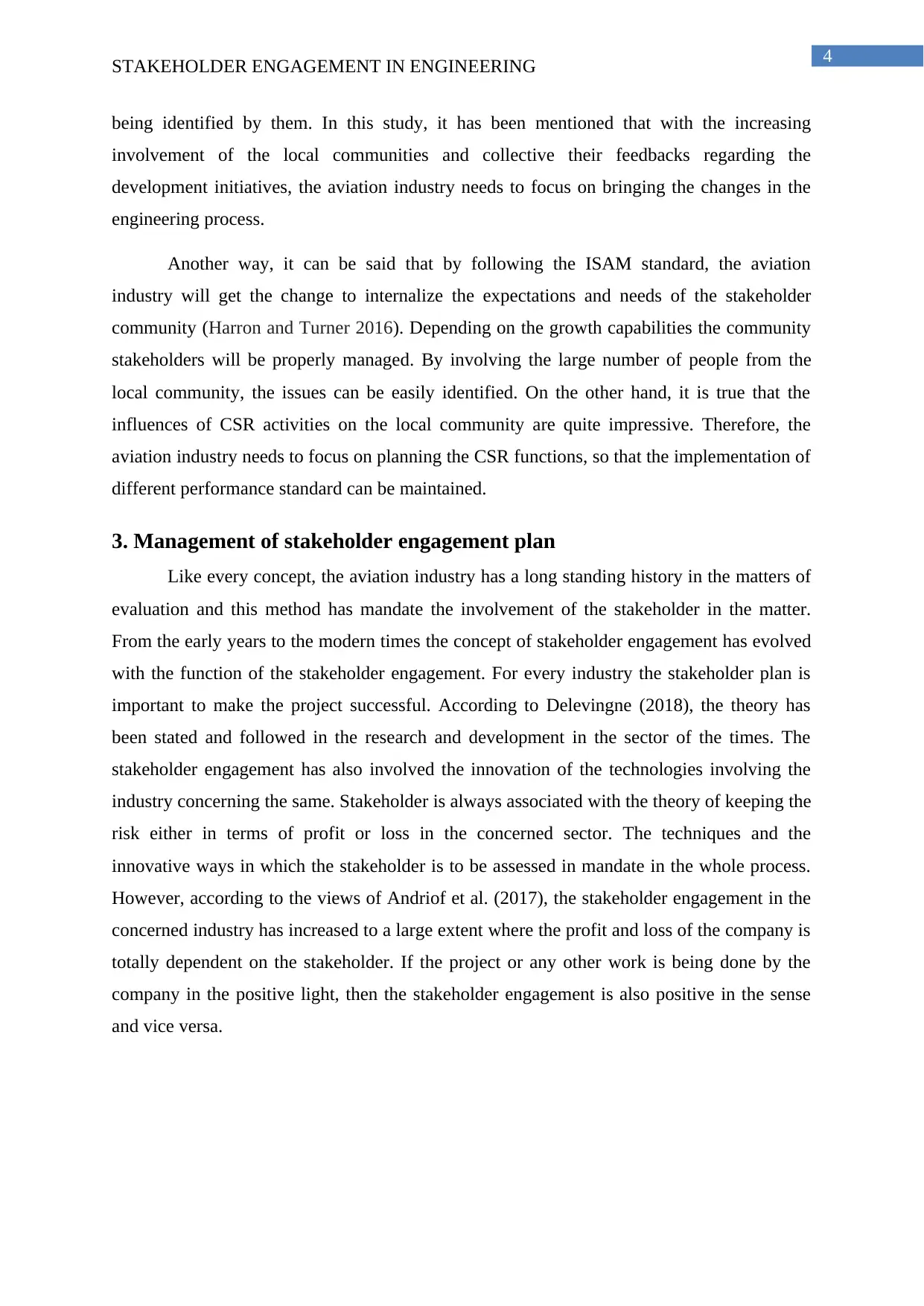
4
STAKEHOLDER ENGAGEMENT IN ENGINEERING
being identified by them. In this study, it has been mentioned that with the increasing
involvement of the local communities and collective their feedbacks regarding the
development initiatives, the aviation industry needs to focus on bringing the changes in the
engineering process.
Another way, it can be said that by following the ISAM standard, the aviation
industry will get the change to internalize the expectations and needs of the stakeholder
community (Harron and Turner 2016). Depending on the growth capabilities the community
stakeholders will be properly managed. By involving the large number of people from the
local community, the issues can be easily identified. On the other hand, it is true that the
influences of CSR activities on the local community are quite impressive. Therefore, the
aviation industry needs to focus on planning the CSR functions, so that the implementation of
different performance standard can be maintained.
3. Management of stakeholder engagement plan
Like every concept, the aviation industry has a long standing history in the matters of
evaluation and this method has mandate the involvement of the stakeholder in the matter.
From the early years to the modern times the concept of stakeholder engagement has evolved
with the function of the stakeholder engagement. For every industry the stakeholder plan is
important to make the project successful. According to Delevingne (2018), the theory has
been stated and followed in the research and development in the sector of the times. The
stakeholder engagement has also involved the innovation of the technologies involving the
industry concerning the same. Stakeholder is always associated with the theory of keeping the
risk either in terms of profit or loss in the concerned sector. The techniques and the
innovative ways in which the stakeholder is to be assessed in mandate in the whole process.
However, according to the views of Andriof et al. (2017), the stakeholder engagement in the
concerned industry has increased to a large extent where the profit and loss of the company is
totally dependent on the stakeholder. If the project or any other work is being done by the
company in the positive light, then the stakeholder engagement is also positive in the sense
and vice versa.
STAKEHOLDER ENGAGEMENT IN ENGINEERING
being identified by them. In this study, it has been mentioned that with the increasing
involvement of the local communities and collective their feedbacks regarding the
development initiatives, the aviation industry needs to focus on bringing the changes in the
engineering process.
Another way, it can be said that by following the ISAM standard, the aviation
industry will get the change to internalize the expectations and needs of the stakeholder
community (Harron and Turner 2016). Depending on the growth capabilities the community
stakeholders will be properly managed. By involving the large number of people from the
local community, the issues can be easily identified. On the other hand, it is true that the
influences of CSR activities on the local community are quite impressive. Therefore, the
aviation industry needs to focus on planning the CSR functions, so that the implementation of
different performance standard can be maintained.
3. Management of stakeholder engagement plan
Like every concept, the aviation industry has a long standing history in the matters of
evaluation and this method has mandate the involvement of the stakeholder in the matter.
From the early years to the modern times the concept of stakeholder engagement has evolved
with the function of the stakeholder engagement. For every industry the stakeholder plan is
important to make the project successful. According to Delevingne (2018), the theory has
been stated and followed in the research and development in the sector of the times. The
stakeholder engagement has also involved the innovation of the technologies involving the
industry concerning the same. Stakeholder is always associated with the theory of keeping the
risk either in terms of profit or loss in the concerned sector. The techniques and the
innovative ways in which the stakeholder is to be assessed in mandate in the whole process.
However, according to the views of Andriof et al. (2017), the stakeholder engagement in the
concerned industry has increased to a large extent where the profit and loss of the company is
totally dependent on the stakeholder. If the project or any other work is being done by the
company in the positive light, then the stakeholder engagement is also positive in the sense
and vice versa.
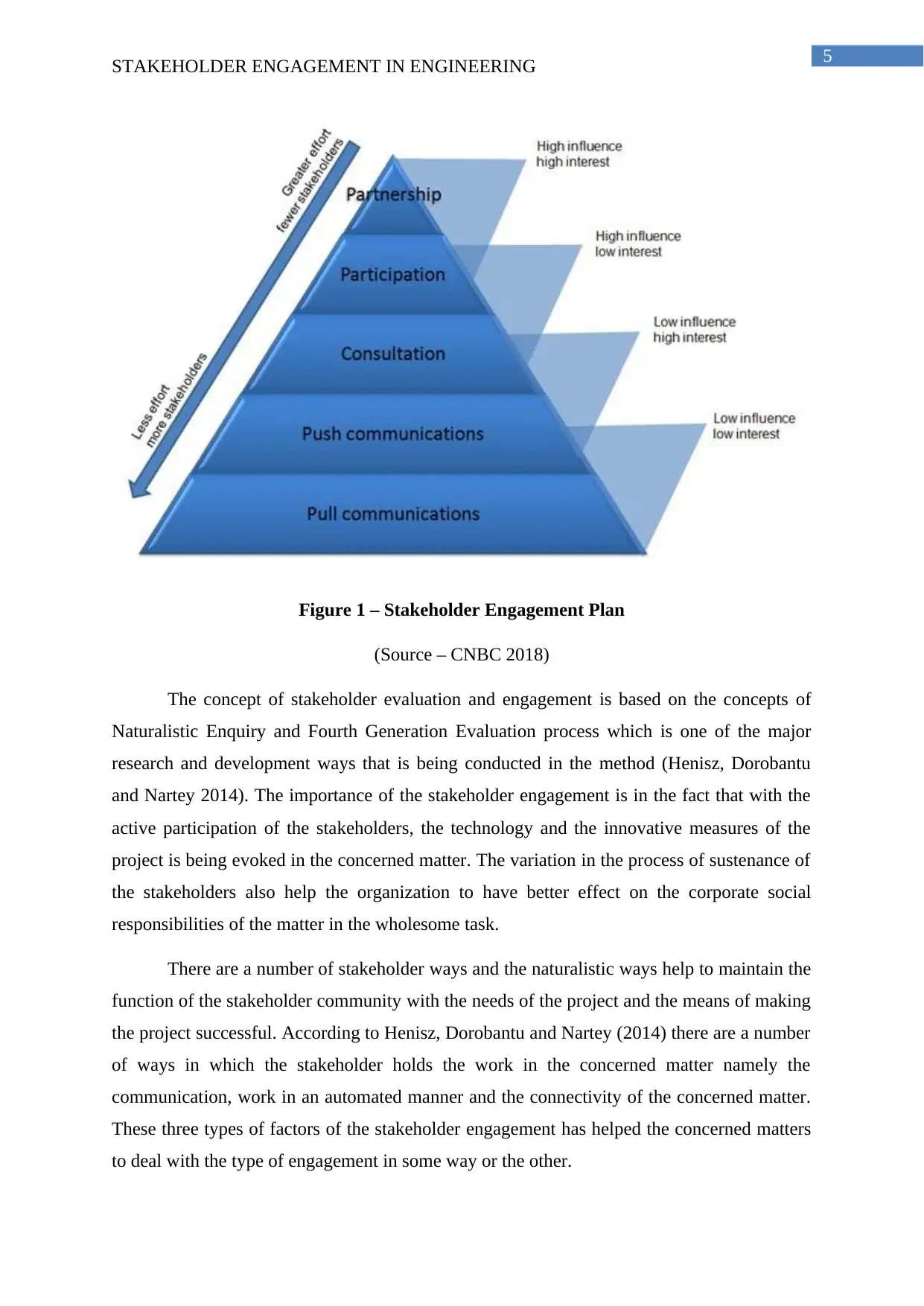
5
STAKEHOLDER ENGAGEMENT IN ENGINEERING
Figure 1 – Stakeholder Engagement Plan
(Source – CNBC 2018)
The concept of stakeholder evaluation and engagement is based on the concepts of
Naturalistic Enquiry and Fourth Generation Evaluation process which is one of the major
research and development ways that is being conducted in the method (Henisz, Dorobantu
and Nartey 2014). The importance of the stakeholder engagement is in the fact that with the
active participation of the stakeholders, the technology and the innovative measures of the
project is being evoked in the concerned matter. The variation in the process of sustenance of
the stakeholders also help the organization to have better effect on the corporate social
responsibilities of the matter in the wholesome task.
There are a number of stakeholder ways and the naturalistic ways help to maintain the
function of the stakeholder community with the needs of the project and the means of making
the project successful. According to Henisz, Dorobantu and Nartey (2014) there are a number
of ways in which the stakeholder holds the work in the concerned matter namely the
communication, work in an automated manner and the connectivity of the concerned matter.
These three types of factors of the stakeholder engagement has helped the concerned matters
to deal with the type of engagement in some way or the other.
STAKEHOLDER ENGAGEMENT IN ENGINEERING
Figure 1 – Stakeholder Engagement Plan
(Source – CNBC 2018)
The concept of stakeholder evaluation and engagement is based on the concepts of
Naturalistic Enquiry and Fourth Generation Evaluation process which is one of the major
research and development ways that is being conducted in the method (Henisz, Dorobantu
and Nartey 2014). The importance of the stakeholder engagement is in the fact that with the
active participation of the stakeholders, the technology and the innovative measures of the
project is being evoked in the concerned matter. The variation in the process of sustenance of
the stakeholders also help the organization to have better effect on the corporate social
responsibilities of the matter in the wholesome task.
There are a number of stakeholder ways and the naturalistic ways help to maintain the
function of the stakeholder community with the needs of the project and the means of making
the project successful. According to Henisz, Dorobantu and Nartey (2014) there are a number
of ways in which the stakeholder holds the work in the concerned matter namely the
communication, work in an automated manner and the connectivity of the concerned matter.
These three types of factors of the stakeholder engagement has helped the concerned matters
to deal with the type of engagement in some way or the other.
⊘ This is a preview!⊘
Do you want full access?
Subscribe today to unlock all pages.

Trusted by 1+ million students worldwide
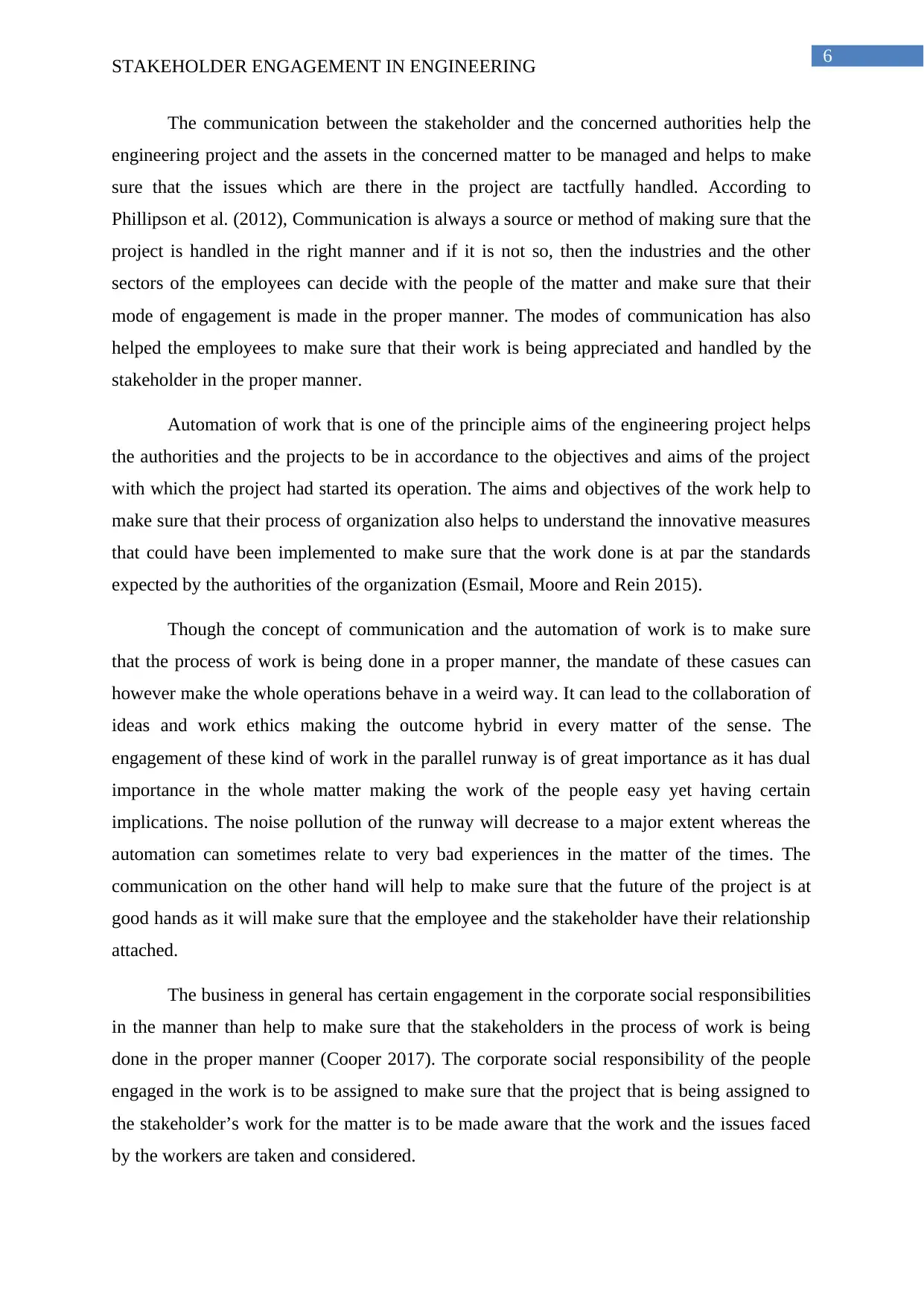
6
STAKEHOLDER ENGAGEMENT IN ENGINEERING
The communication between the stakeholder and the concerned authorities help the
engineering project and the assets in the concerned matter to be managed and helps to make
sure that the issues which are there in the project are tactfully handled. According to
Phillipson et al. (2012), Communication is always a source or method of making sure that the
project is handled in the right manner and if it is not so, then the industries and the other
sectors of the employees can decide with the people of the matter and make sure that their
mode of engagement is made in the proper manner. The modes of communication has also
helped the employees to make sure that their work is being appreciated and handled by the
stakeholder in the proper manner.
Automation of work that is one of the principle aims of the engineering project helps
the authorities and the projects to be in accordance to the objectives and aims of the project
with which the project had started its operation. The aims and objectives of the work help to
make sure that their process of organization also helps to understand the innovative measures
that could have been implemented to make sure that the work done is at par the standards
expected by the authorities of the organization (Esmail, Moore and Rein 2015).
Though the concept of communication and the automation of work is to make sure
that the process of work is being done in a proper manner, the mandate of these casues can
however make the whole operations behave in a weird way. It can lead to the collaboration of
ideas and work ethics making the outcome hybrid in every matter of the sense. The
engagement of these kind of work in the parallel runway is of great importance as it has dual
importance in the whole matter making the work of the people easy yet having certain
implications. The noise pollution of the runway will decrease to a major extent whereas the
automation can sometimes relate to very bad experiences in the matter of the times. The
communication on the other hand will help to make sure that the future of the project is at
good hands as it will make sure that the employee and the stakeholder have their relationship
attached.
The business in general has certain engagement in the corporate social responsibilities
in the manner than help to make sure that the stakeholders in the process of work is being
done in the proper manner (Cooper 2017). The corporate social responsibility of the people
engaged in the work is to be assigned to make sure that the project that is being assigned to
the stakeholder’s work for the matter is to be made aware that the work and the issues faced
by the workers are taken and considered.
STAKEHOLDER ENGAGEMENT IN ENGINEERING
The communication between the stakeholder and the concerned authorities help the
engineering project and the assets in the concerned matter to be managed and helps to make
sure that the issues which are there in the project are tactfully handled. According to
Phillipson et al. (2012), Communication is always a source or method of making sure that the
project is handled in the right manner and if it is not so, then the industries and the other
sectors of the employees can decide with the people of the matter and make sure that their
mode of engagement is made in the proper manner. The modes of communication has also
helped the employees to make sure that their work is being appreciated and handled by the
stakeholder in the proper manner.
Automation of work that is one of the principle aims of the engineering project helps
the authorities and the projects to be in accordance to the objectives and aims of the project
with which the project had started its operation. The aims and objectives of the work help to
make sure that their process of organization also helps to understand the innovative measures
that could have been implemented to make sure that the work done is at par the standards
expected by the authorities of the organization (Esmail, Moore and Rein 2015).
Though the concept of communication and the automation of work is to make sure
that the process of work is being done in a proper manner, the mandate of these casues can
however make the whole operations behave in a weird way. It can lead to the collaboration of
ideas and work ethics making the outcome hybrid in every matter of the sense. The
engagement of these kind of work in the parallel runway is of great importance as it has dual
importance in the whole matter making the work of the people easy yet having certain
implications. The noise pollution of the runway will decrease to a major extent whereas the
automation can sometimes relate to very bad experiences in the matter of the times. The
communication on the other hand will help to make sure that the future of the project is at
good hands as it will make sure that the employee and the stakeholder have their relationship
attached.
The business in general has certain engagement in the corporate social responsibilities
in the manner than help to make sure that the stakeholders in the process of work is being
done in the proper manner (Cooper 2017). The corporate social responsibility of the people
engaged in the work is to be assigned to make sure that the project that is being assigned to
the stakeholder’s work for the matter is to be made aware that the work and the issues faced
by the workers are taken and considered.
Paraphrase This Document
Need a fresh take? Get an instant paraphrase of this document with our AI Paraphraser
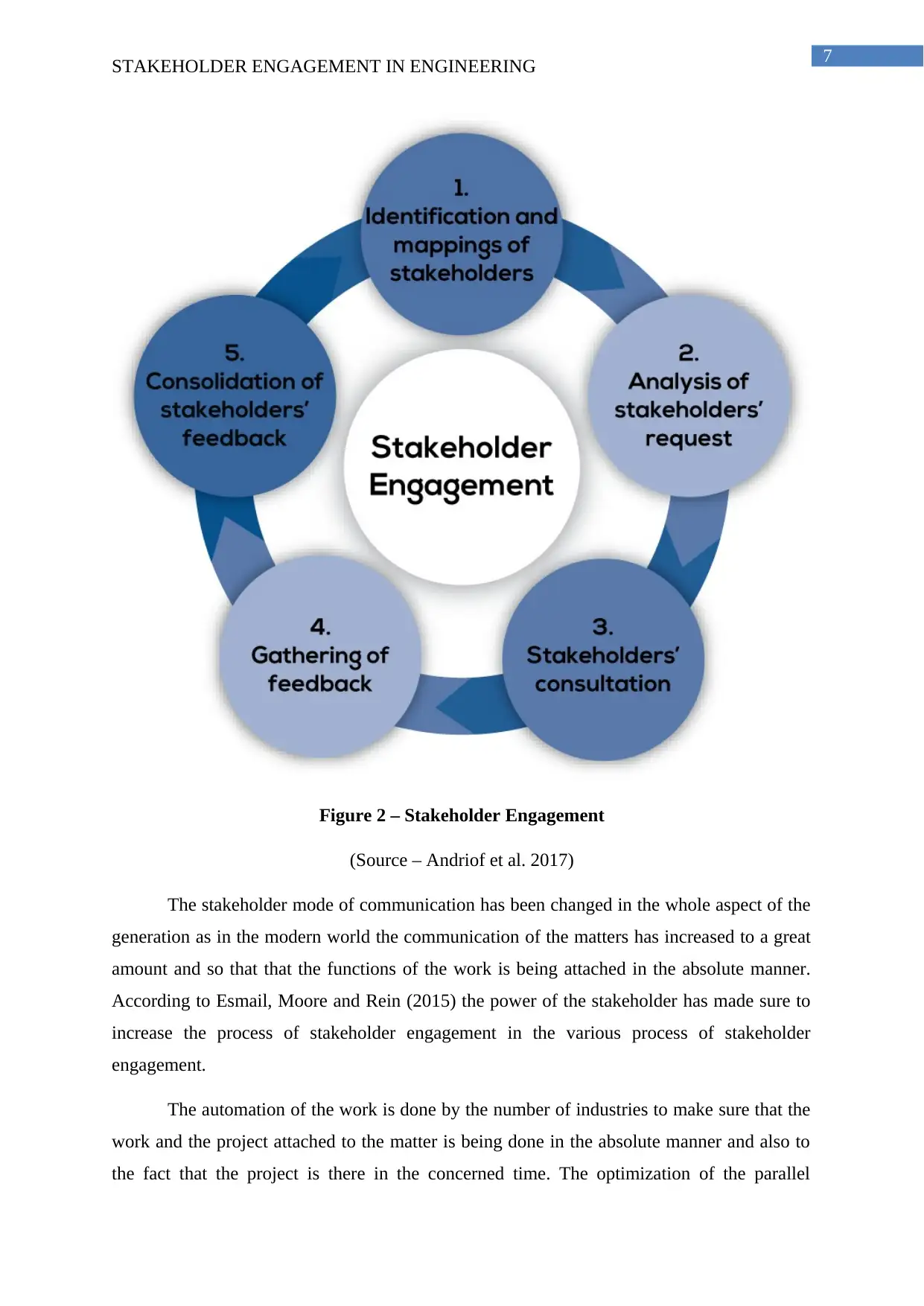
7
STAKEHOLDER ENGAGEMENT IN ENGINEERING
Figure 2 – Stakeholder Engagement
(Source – Andriof et al. 2017)
The stakeholder mode of communication has been changed in the whole aspect of the
generation as in the modern world the communication of the matters has increased to a great
amount and so that that the functions of the work is being attached in the absolute manner.
According to Esmail, Moore and Rein (2015) the power of the stakeholder has made sure to
increase the process of stakeholder engagement in the various process of stakeholder
engagement.
The automation of the work is done by the number of industries to make sure that the
work and the project attached to the matter is being done in the absolute manner and also to
the fact that the project is there in the concerned time. The optimization of the parallel
STAKEHOLDER ENGAGEMENT IN ENGINEERING
Figure 2 – Stakeholder Engagement
(Source – Andriof et al. 2017)
The stakeholder mode of communication has been changed in the whole aspect of the
generation as in the modern world the communication of the matters has increased to a great
amount and so that that the functions of the work is being attached in the absolute manner.
According to Esmail, Moore and Rein (2015) the power of the stakeholder has made sure to
increase the process of stakeholder engagement in the various process of stakeholder
engagement.
The automation of the work is done by the number of industries to make sure that the
work and the project attached to the matter is being done in the absolute manner and also to
the fact that the project is there in the concerned time. The optimization of the parallel
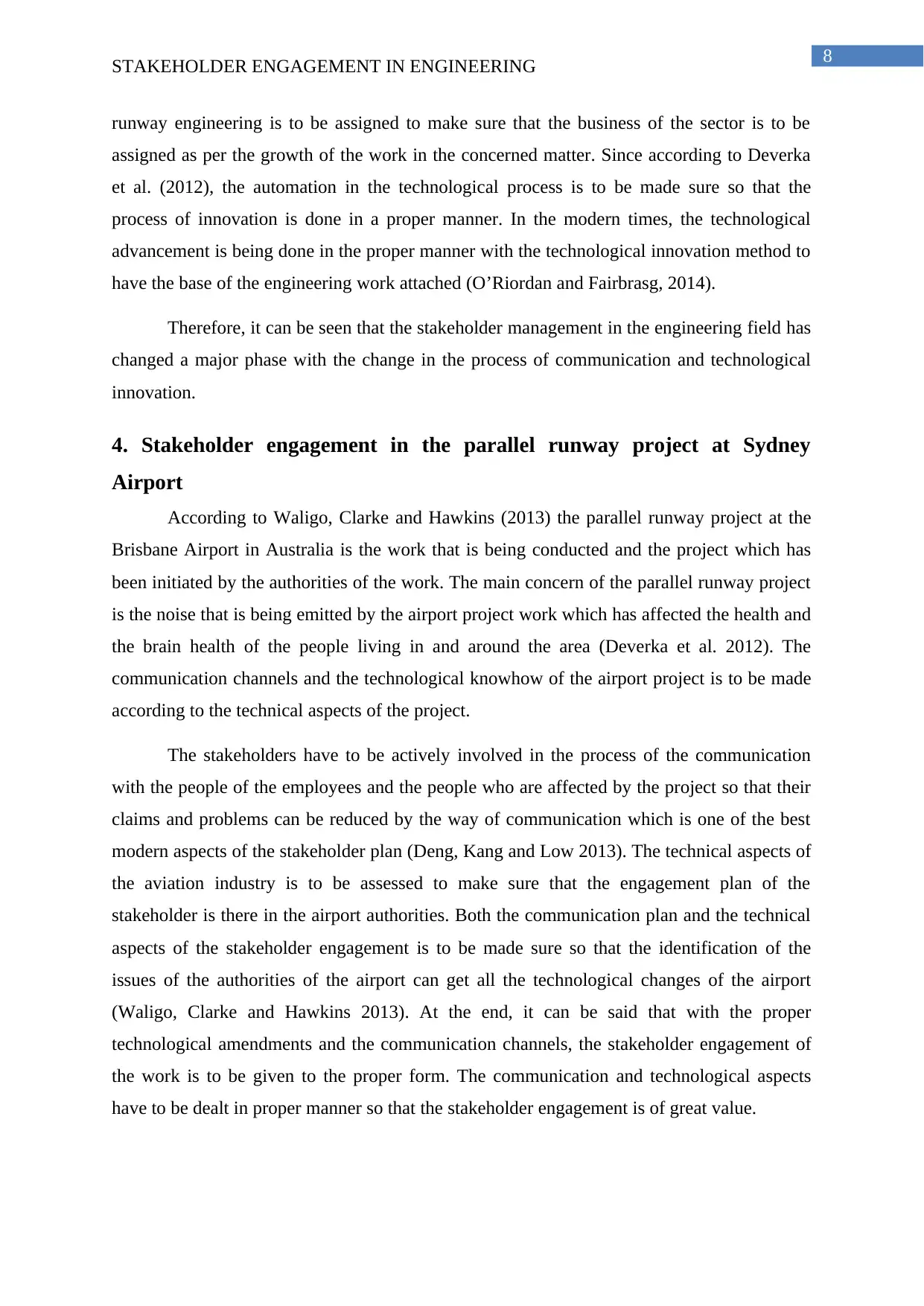
8
STAKEHOLDER ENGAGEMENT IN ENGINEERING
runway engineering is to be assigned to make sure that the business of the sector is to be
assigned as per the growth of the work in the concerned matter. Since according to Deverka
et al. (2012), the automation in the technological process is to be made sure so that the
process of innovation is done in a proper manner. In the modern times, the technological
advancement is being done in the proper manner with the technological innovation method to
have the base of the engineering work attached (O’Riordan and Fairbrasg, 2014).
Therefore, it can be seen that the stakeholder management in the engineering field has
changed a major phase with the change in the process of communication and technological
innovation.
4. Stakeholder engagement in the parallel runway project at Sydney
Airport
According to Waligo, Clarke and Hawkins (2013) the parallel runway project at the
Brisbane Airport in Australia is the work that is being conducted and the project which has
been initiated by the authorities of the work. The main concern of the parallel runway project
is the noise that is being emitted by the airport project work which has affected the health and
the brain health of the people living in and around the area (Deverka et al. 2012). The
communication channels and the technological knowhow of the airport project is to be made
according to the technical aspects of the project.
The stakeholders have to be actively involved in the process of the communication
with the people of the employees and the people who are affected by the project so that their
claims and problems can be reduced by the way of communication which is one of the best
modern aspects of the stakeholder plan (Deng, Kang and Low 2013). The technical aspects of
the aviation industry is to be assessed to make sure that the engagement plan of the
stakeholder is there in the airport authorities. Both the communication plan and the technical
aspects of the stakeholder engagement is to be made sure so that the identification of the
issues of the authorities of the airport can get all the technological changes of the airport
(Waligo, Clarke and Hawkins 2013). At the end, it can be said that with the proper
technological amendments and the communication channels, the stakeholder engagement of
the work is to be given to the proper form. The communication and technological aspects
have to be dealt in proper manner so that the stakeholder engagement is of great value.
STAKEHOLDER ENGAGEMENT IN ENGINEERING
runway engineering is to be assigned to make sure that the business of the sector is to be
assigned as per the growth of the work in the concerned matter. Since according to Deverka
et al. (2012), the automation in the technological process is to be made sure so that the
process of innovation is done in a proper manner. In the modern times, the technological
advancement is being done in the proper manner with the technological innovation method to
have the base of the engineering work attached (O’Riordan and Fairbrasg, 2014).
Therefore, it can be seen that the stakeholder management in the engineering field has
changed a major phase with the change in the process of communication and technological
innovation.
4. Stakeholder engagement in the parallel runway project at Sydney
Airport
According to Waligo, Clarke and Hawkins (2013) the parallel runway project at the
Brisbane Airport in Australia is the work that is being conducted and the project which has
been initiated by the authorities of the work. The main concern of the parallel runway project
is the noise that is being emitted by the airport project work which has affected the health and
the brain health of the people living in and around the area (Deverka et al. 2012). The
communication channels and the technological knowhow of the airport project is to be made
according to the technical aspects of the project.
The stakeholders have to be actively involved in the process of the communication
with the people of the employees and the people who are affected by the project so that their
claims and problems can be reduced by the way of communication which is one of the best
modern aspects of the stakeholder plan (Deng, Kang and Low 2013). The technical aspects of
the aviation industry is to be assessed to make sure that the engagement plan of the
stakeholder is there in the airport authorities. Both the communication plan and the technical
aspects of the stakeholder engagement is to be made sure so that the identification of the
issues of the authorities of the airport can get all the technological changes of the airport
(Waligo, Clarke and Hawkins 2013). At the end, it can be said that with the proper
technological amendments and the communication channels, the stakeholder engagement of
the work is to be given to the proper form. The communication and technological aspects
have to be dealt in proper manner so that the stakeholder engagement is of great value.
⊘ This is a preview!⊘
Do you want full access?
Subscribe today to unlock all pages.

Trusted by 1+ million students worldwide

9
STAKEHOLDER ENGAGEMENT IN ENGINEERING
5. Summary
Summarising, it can be said that with the proper implementation of the
communication channels and the technological knowhow, it can be seen that the stakeholder
engagement of the Brisbane airport can be made in the proper order of modern world. The
literature review is based upon the concept of the stakeholder engagement in the parallel
airport task and also the objectives and aims of the stakeholder are being assessed. The
stakeholder engagement of the modern world and its evaluation from the past is also being
assessed which is one of the major ways to draw the task of the technological engineering
management. The stakeholders have a vital role to play and so they are actively involved in
both the pro and the cons of the work in related matter.
STAKEHOLDER ENGAGEMENT IN ENGINEERING
5. Summary
Summarising, it can be said that with the proper implementation of the
communication channels and the technological knowhow, it can be seen that the stakeholder
engagement of the Brisbane airport can be made in the proper order of modern world. The
literature review is based upon the concept of the stakeholder engagement in the parallel
airport task and also the objectives and aims of the stakeholder are being assessed. The
stakeholder engagement of the modern world and its evaluation from the past is also being
assessed which is one of the major ways to draw the task of the technological engineering
management. The stakeholders have a vital role to play and so they are actively involved in
both the pro and the cons of the work in related matter.
Paraphrase This Document
Need a fresh take? Get an instant paraphrase of this document with our AI Paraphraser
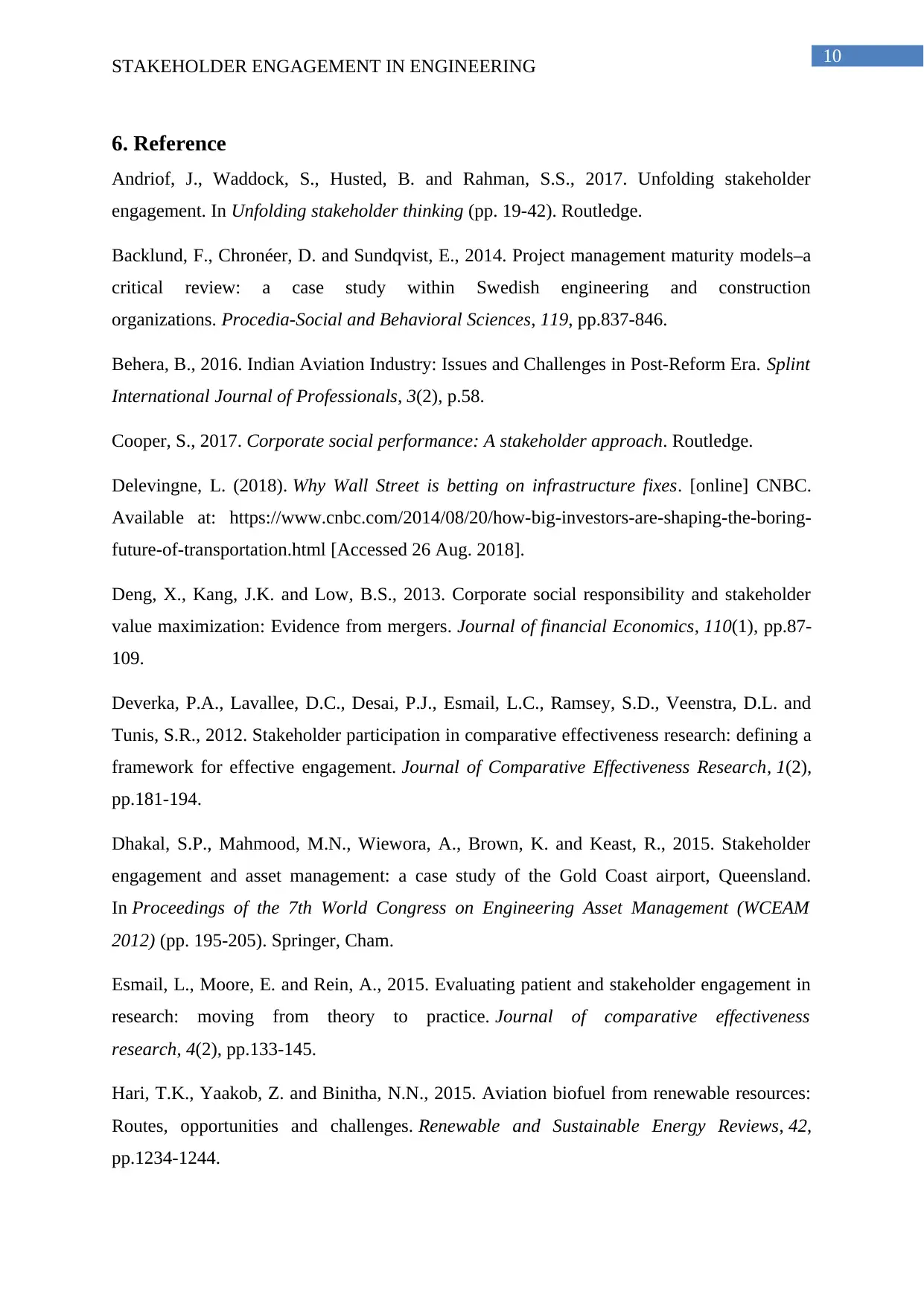
10
STAKEHOLDER ENGAGEMENT IN ENGINEERING
6. Reference
Andriof, J., Waddock, S., Husted, B. and Rahman, S.S., 2017. Unfolding stakeholder
engagement. In Unfolding stakeholder thinking (pp. 19-42). Routledge.
Backlund, F., Chronéer, D. and Sundqvist, E., 2014. Project management maturity models–a
critical review: a case study within Swedish engineering and construction
organizations. Procedia-Social and Behavioral Sciences, 119, pp.837-846.
Behera, B., 2016. Indian Aviation Industry: Issues and Challenges in Post-Reform Era. Splint
International Journal of Professionals, 3(2), p.58.
Cooper, S., 2017. Corporate social performance: A stakeholder approach. Routledge.
Delevingne, L. (2018). Why Wall Street is betting on infrastructure fixes. [online] CNBC.
Available at: https://www.cnbc.com/2014/08/20/how-big-investors-are-shaping-the-boring-
future-of-transportation.html [Accessed 26 Aug. 2018].
Deng, X., Kang, J.K. and Low, B.S., 2013. Corporate social responsibility and stakeholder
value maximization: Evidence from mergers. Journal of financial Economics, 110(1), pp.87-
109.
Deverka, P.A., Lavallee, D.C., Desai, P.J., Esmail, L.C., Ramsey, S.D., Veenstra, D.L. and
Tunis, S.R., 2012. Stakeholder participation in comparative effectiveness research: defining a
framework for effective engagement. Journal of Comparative Effectiveness Research, 1(2),
pp.181-194.
Dhakal, S.P., Mahmood, M.N., Wiewora, A., Brown, K. and Keast, R., 2015. Stakeholder
engagement and asset management: a case study of the Gold Coast airport, Queensland.
In Proceedings of the 7th World Congress on Engineering Asset Management (WCEAM
2012) (pp. 195-205). Springer, Cham.
Esmail, L., Moore, E. and Rein, A., 2015. Evaluating patient and stakeholder engagement in
research: moving from theory to practice. Journal of comparative effectiveness
research, 4(2), pp.133-145.
Hari, T.K., Yaakob, Z. and Binitha, N.N., 2015. Aviation biofuel from renewable resources:
Routes, opportunities and challenges. Renewable and Sustainable Energy Reviews, 42,
pp.1234-1244.
STAKEHOLDER ENGAGEMENT IN ENGINEERING
6. Reference
Andriof, J., Waddock, S., Husted, B. and Rahman, S.S., 2017. Unfolding stakeholder
engagement. In Unfolding stakeholder thinking (pp. 19-42). Routledge.
Backlund, F., Chronéer, D. and Sundqvist, E., 2014. Project management maturity models–a
critical review: a case study within Swedish engineering and construction
organizations. Procedia-Social and Behavioral Sciences, 119, pp.837-846.
Behera, B., 2016. Indian Aviation Industry: Issues and Challenges in Post-Reform Era. Splint
International Journal of Professionals, 3(2), p.58.
Cooper, S., 2017. Corporate social performance: A stakeholder approach. Routledge.
Delevingne, L. (2018). Why Wall Street is betting on infrastructure fixes. [online] CNBC.
Available at: https://www.cnbc.com/2014/08/20/how-big-investors-are-shaping-the-boring-
future-of-transportation.html [Accessed 26 Aug. 2018].
Deng, X., Kang, J.K. and Low, B.S., 2013. Corporate social responsibility and stakeholder
value maximization: Evidence from mergers. Journal of financial Economics, 110(1), pp.87-
109.
Deverka, P.A., Lavallee, D.C., Desai, P.J., Esmail, L.C., Ramsey, S.D., Veenstra, D.L. and
Tunis, S.R., 2012. Stakeholder participation in comparative effectiveness research: defining a
framework for effective engagement. Journal of Comparative Effectiveness Research, 1(2),
pp.181-194.
Dhakal, S.P., Mahmood, M.N., Wiewora, A., Brown, K. and Keast, R., 2015. Stakeholder
engagement and asset management: a case study of the Gold Coast airport, Queensland.
In Proceedings of the 7th World Congress on Engineering Asset Management (WCEAM
2012) (pp. 195-205). Springer, Cham.
Esmail, L., Moore, E. and Rein, A., 2015. Evaluating patient and stakeholder engagement in
research: moving from theory to practice. Journal of comparative effectiveness
research, 4(2), pp.133-145.
Hari, T.K., Yaakob, Z. and Binitha, N.N., 2015. Aviation biofuel from renewable resources:
Routes, opportunities and challenges. Renewable and Sustainable Energy Reviews, 42,
pp.1234-1244.
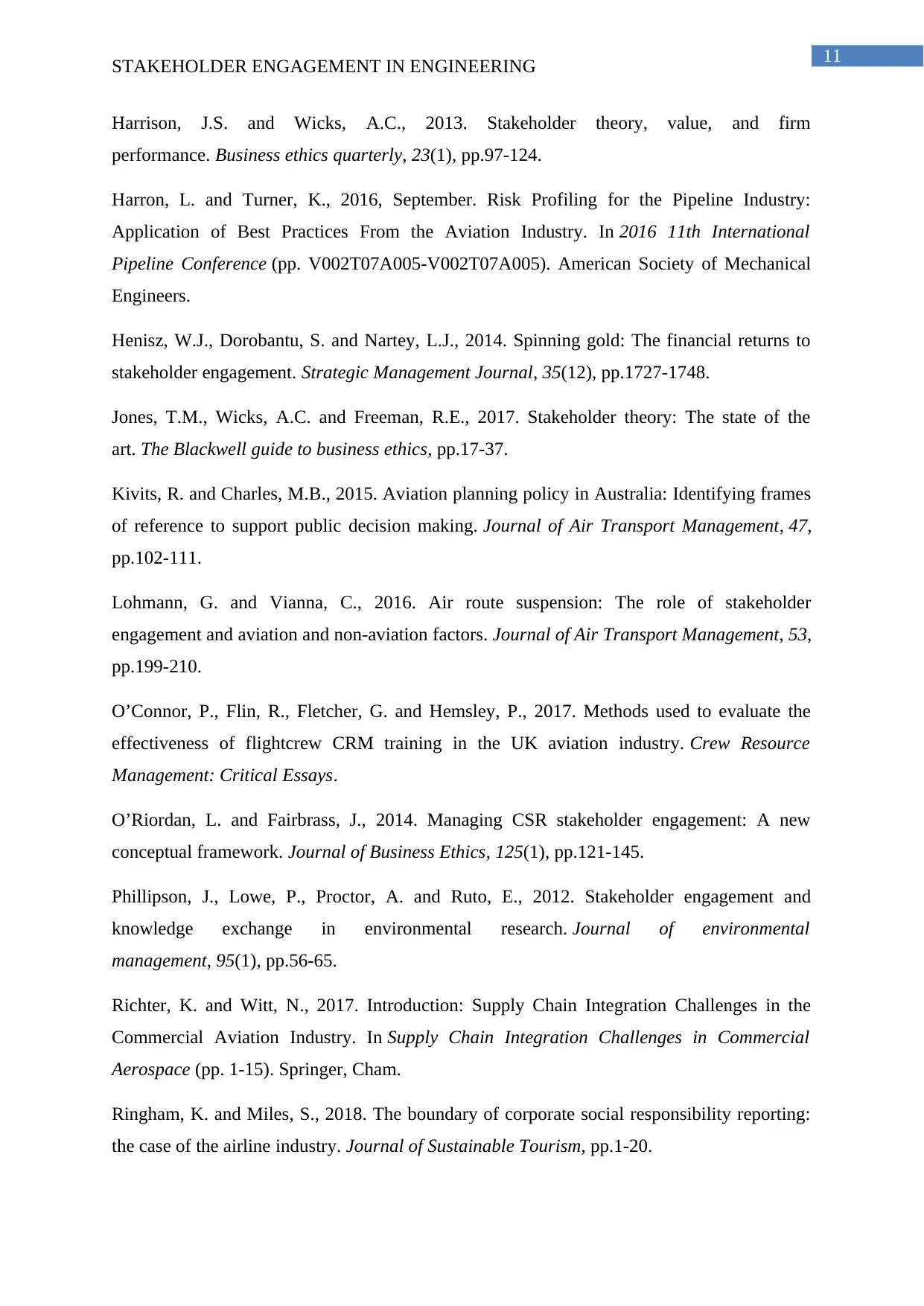
11
STAKEHOLDER ENGAGEMENT IN ENGINEERING
Harrison, J.S. and Wicks, A.C., 2013. Stakeholder theory, value, and firm
performance. Business ethics quarterly, 23(1), pp.97-124.
Harron, L. and Turner, K., 2016, September. Risk Profiling for the Pipeline Industry:
Application of Best Practices From the Aviation Industry. In 2016 11th International
Pipeline Conference (pp. V002T07A005-V002T07A005). American Society of Mechanical
Engineers.
Henisz, W.J., Dorobantu, S. and Nartey, L.J., 2014. Spinning gold: The financial returns to
stakeholder engagement. Strategic Management Journal, 35(12), pp.1727-1748.
Jones, T.M., Wicks, A.C. and Freeman, R.E., 2017. Stakeholder theory: The state of the
art. The Blackwell guide to business ethics, pp.17-37.
Kivits, R. and Charles, M.B., 2015. Aviation planning policy in Australia: Identifying frames
of reference to support public decision making. Journal of Air Transport Management, 47,
pp.102-111.
Lohmann, G. and Vianna, C., 2016. Air route suspension: The role of stakeholder
engagement and aviation and non-aviation factors. Journal of Air Transport Management, 53,
pp.199-210.
O’Connor, P., Flin, R., Fletcher, G. and Hemsley, P., 2017. Methods used to evaluate the
effectiveness of flightcrew CRM training in the UK aviation industry. Crew Resource
Management: Critical Essays.
O’Riordan, L. and Fairbrass, J., 2014. Managing CSR stakeholder engagement: A new
conceptual framework. Journal of Business Ethics, 125(1), pp.121-145.
Phillipson, J., Lowe, P., Proctor, A. and Ruto, E., 2012. Stakeholder engagement and
knowledge exchange in environmental research. Journal of environmental
management, 95(1), pp.56-65.
Richter, K. and Witt, N., 2017. Introduction: Supply Chain Integration Challenges in the
Commercial Aviation Industry. In Supply Chain Integration Challenges in Commercial
Aerospace (pp. 1-15). Springer, Cham.
Ringham, K. and Miles, S., 2018. The boundary of corporate social responsibility reporting:
the case of the airline industry. Journal of Sustainable Tourism, pp.1-20.
STAKEHOLDER ENGAGEMENT IN ENGINEERING
Harrison, J.S. and Wicks, A.C., 2013. Stakeholder theory, value, and firm
performance. Business ethics quarterly, 23(1), pp.97-124.
Harron, L. and Turner, K., 2016, September. Risk Profiling for the Pipeline Industry:
Application of Best Practices From the Aviation Industry. In 2016 11th International
Pipeline Conference (pp. V002T07A005-V002T07A005). American Society of Mechanical
Engineers.
Henisz, W.J., Dorobantu, S. and Nartey, L.J., 2014. Spinning gold: The financial returns to
stakeholder engagement. Strategic Management Journal, 35(12), pp.1727-1748.
Jones, T.M., Wicks, A.C. and Freeman, R.E., 2017. Stakeholder theory: The state of the
art. The Blackwell guide to business ethics, pp.17-37.
Kivits, R. and Charles, M.B., 2015. Aviation planning policy in Australia: Identifying frames
of reference to support public decision making. Journal of Air Transport Management, 47,
pp.102-111.
Lohmann, G. and Vianna, C., 2016. Air route suspension: The role of stakeholder
engagement and aviation and non-aviation factors. Journal of Air Transport Management, 53,
pp.199-210.
O’Connor, P., Flin, R., Fletcher, G. and Hemsley, P., 2017. Methods used to evaluate the
effectiveness of flightcrew CRM training in the UK aviation industry. Crew Resource
Management: Critical Essays.
O’Riordan, L. and Fairbrass, J., 2014. Managing CSR stakeholder engagement: A new
conceptual framework. Journal of Business Ethics, 125(1), pp.121-145.
Phillipson, J., Lowe, P., Proctor, A. and Ruto, E., 2012. Stakeholder engagement and
knowledge exchange in environmental research. Journal of environmental
management, 95(1), pp.56-65.
Richter, K. and Witt, N., 2017. Introduction: Supply Chain Integration Challenges in the
Commercial Aviation Industry. In Supply Chain Integration Challenges in Commercial
Aerospace (pp. 1-15). Springer, Cham.
Ringham, K. and Miles, S., 2018. The boundary of corporate social responsibility reporting:
the case of the airline industry. Journal of Sustainable Tourism, pp.1-20.
⊘ This is a preview!⊘
Do you want full access?
Subscribe today to unlock all pages.

Trusted by 1+ million students worldwide
1 out of 13
Related Documents
Your All-in-One AI-Powered Toolkit for Academic Success.
+13062052269
info@desklib.com
Available 24*7 on WhatsApp / Email
![[object Object]](/_next/static/media/star-bottom.7253800d.svg)
Unlock your academic potential
Copyright © 2020–2025 A2Z Services. All Rights Reserved. Developed and managed by ZUCOL.





